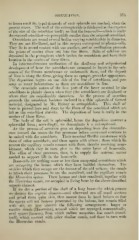Page 565 - My FlipBook
P. 565
OSSIFICATION. 5/5
to lessen until the typal demands of each spherule are reached, when the
process ceases. The wall of the calcospherule is thickened at the expense
of the size of the osteoblast itself; so that the bone-cell—which is really
the encased osteoblast—is perceptibly smaller than the original osteoblast.
Osteoblasts are round or oval bodies varying considerably in diameter.
They are not fibrillated, and in this respect correspond to plasma-cells.
They lie in actual contact with one another, and as ossification proceeds
the points of contact draw out into fine fibres. Salts of calcium are
deposited in the protoplasm which bathes the osteoblasts and have their
location in the meshes of these fibres.
In intermembranous ossification of the skull-cap and subperiosteal
development of bone the osteoblasts -are arranged in layers in the sub-
stance of the fibrous membranes or underneath them, and the deposit
of lime is along the fibres, giving them an opaque, granular appearance.
The deposition begins on one side of the line of osteoblasts, and pre-
sents as many indentations as there are osteoblasts in line.
The crescentic nature of the first part of the layer secreted by the
osteoblasts is plainly shown when they (the osteoblasts) are displaced or
where thev are considerably shrunken. As the process of secretion
proceeds the osteoblast becomes enclosed in a thin spherule of formed
material, designated by Mr. Rainey as mlcoglobulln. This shell of
bone is pierced here and there by the fibres of the osteoblast which are
left^ as the osteoblast shrinks. The deposition of bone is really in the
meshes of these fibres.
The body of the cell is spheroidal, hence the deposition assumes a
spheroidal form ; accordingly, we denominate it a calcosphende.
As the process of secretion goes on depositing from the circumfer-
ence toward the centre the fine processes before mentioned continue to
be united with the osteoblasts. Their terminal fibrillre anastomose with
those of other osteoblasts, and these again with others ; those which lie
nearest the capillary vessels connect with them, thereby receiving nour-
ishment, which they in turn give to the outer layer of bone-cells.
The office of these processes, then, is to supply the nutrient matter
needed to support life in the bone-cells.
Bone-cells are nothing more or less than encapsuled osteoblasts which
are occupying the homes which they have builded themselves. The
cavities which they occupy are the lacunce of the old writers ; the canals
in which their processes lie are the canalicuU, and the capillary vessels
the Haversian system. These lacunae and their canaliculi, together with
the Haversian canals, are occupied in living bone by the above-described
organic element.
If we dry a portion of the shaft of a long bone— by which process
we destroy the organic element—and afterward saw oif small sections
and o-rind them quite thin, then mount them in hard balsam so that
the spaces will not become penetrated by the balsam, but remain filled
with air, we may observe the following arrangement : larger or
smaller canals (Haversian), around which are arranged, concentrically,
oval spaces (lacunae), from which radiate numerous fine canals (canal-
iculi), w^iich connect with other similar canals, and these in turn with
the Haversian canals.


